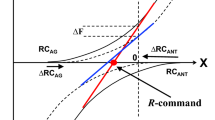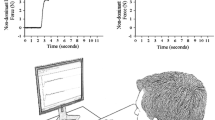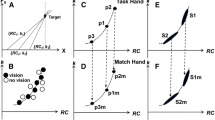Abstract
We examined the ability to match the voluntary isometric finger flexion forces of the dominant and nondominant hand in humans, as well as the influence of unilateral visual feedback during this task. Right-and left-handed subjects were trained to produce a “low” force level (50±25 g) and a “high” force level (200±50 g) with the right and left index finger, separately. Following the training session, subjects were instructed to match the isometric forces of both fingers simultaneously within the required range (either low or high) so that they were perceived to be identical. The results showed an asymmetry, whereby greater forces were exerted with the index finger of the dominant hand. The asymmetry was independent of the subjects' maximum finger flexion strength. When unilateral visual feedback represented the force output of the dominant hand, the asymmetry was no longer present. In contrast, when it represented the force output of the nondominant hand, the asymmetry was not compensated. We hypothesize that these findings are the result of anatomical or physiological asymmetries inherent in the motor system controlling the production of force.
Similar content being viewed by others
References
Aniss AM, Gandevia SC, Milne RJ (1988) Changes in perceived heaviness and motor commands produced by cutaneous reflexes in man. J Physiol (Lond) 397: 113–126
Fagard J, Morioka M, Wolff PH (1985) Early stages in the acquisition of a bimanual motor skill. Neuropsychologia 23: 535–543
Gandevia SC (1987) Roles for perceived voluntary motor commands in motor control. Trends Neurosci 10: 81–85
Gandevia SC, McCloskey DI (1976) Perceived heaviness of lifted objects and effects of sensory inputs from related non-lifting parts. Brain Res 109: 399–401
Gandevia SC, McCloskey DI (1977a) Effects of related sensory inputs on motor performances in man, studied through changes in perceived heaviness. J Physiol (Lond) 272: 653–672
Gandevia SC, McCloskey DI (1977b) Sensations of heaviness. Brain 100: 345–354
Gandevia SC, McCloskey DI (1978) Interpretation of perceived motor commands by reference to afferent signals. I Physiol (Lond) 283: 493–499
Gandevia SC, McCloskey DI, Potter EK (1980) Alterations in perceived heaviness during digital anesthesia. I Physiol (Lond) 306: 365–375
Goodale MA (1988) Hemispheric differences in motor control. Behav Brain Res 30: 203–214
Gordon AM, Forssberg H, Johansson RS, Westling G (1991a) Visual size cues in the programming of manipulative forces during precision grip. Exp Brain Res 83: 477–482
Gordon A, Forssberg H, Johansson R, Westling G (1991b) Integration of sensory information during the programming of precision grip: comments on the contribution of size cues. Exp Brain Res 85: 226–229
Gordon A, Forssberg H, Johansson R, Westling G (1991c) The integration of haptically acquired size information in the programming of precision grip. Exp Brain Res 83: 483–488
Gordon A, Westling G, Cole K, Johansson R (1993) Memory representations underlying motor commands used during manipulation of common and novel objects. J Neurophysiol 69: 1789–1796
Gordon A, Casabona A, Soechting J (1994a) Sequential movement patterns during the relearning of typing. J Neurophysiol 72: 1596–1610
Gordon A, Forssberg H, Iwasaki N (1994b) Formation and lateralization of internal representations underlying motor commands during precision grip. Neuropsychologia 32: 555–568
Honda H (1981) Eye movements and performance during bilateral tracking tasks. Acta Psychol 49: 201–213
Jones LA (1983) Role of central and peripheral signals in force sensation during fatigue. Exp Neurol 81: 497–503
Jones LA (1986) Perception of force and weight: theory and research. Psychol Bull 100: 29–42
Jones LA, Hunter IW (1982) Force separation in isometric contractions: a relative force effect. Brain Res 244: 186–189
Kawashima R, Yamada K, Kinomura S, Yamaguchi T, Matsui H, Yoshioka S, Fukuda H (1993) Regional cerebral blood flow changes of cortical motor areas and prefrontal areas in humans related to ipsilateral and contralateral hand movement. Brain Res 623: 33–40
Kim SG, Ashe J, Hendrich K, Ellermann JM, Merkle H, Ugurbil K, Georgopoulos AP (1993) Functional magnetic resonance imaging of motor cortex: hemispheric asymmetry and handedness. Science 261: 615–617
Kimura D (1977) Acquisition of a motor skill after left hemisphere damage. Brain 100: 527–542
Liepmann H (1908) Die linke Hemisphare und das Handeln. In: Liepmann H (ed) Drei Aufsatze aus dem Apraxiegebiet. Karger, Berlin, pp 17–50
Mai N, Schreiber P, Hermsdorfer J (1991) Changes in perceived finger force produced by muscular contractions under isometric and anisometric conditions. Exp Brain Res 84: 453–460
Marzi CA, Bisiacchi P, Nicoletti R (1991) Is interhemispheric transfer of visuomotor information asymmetric? Evidence from a meta-analysis. Neuropsychologia 29: 1163–1177
McCloskey DI, Ebeling, P Goodwin GM (1974) Estimation of weights and tensions and apparent involvement of a “sense of effort”. Exp Neurol 42: 220–232
McCloskey DI, Gandevia SC, Potter ED, Colebatch JG (1983) Muscle sense and effort. Motor commands and judgments about muscular contractions. In: Desmedt J (ed) Motor control mechanisms in health and disease. Raven, New York, pp 151–168
Nathan PW, Smith MC, Deacon P (1990) The corticospinal tracts in man. Brain 113: 303–324
Nudo RJ, Jenkins WM, Merzenich MM, Prejean T, Grenda R (1992) Neurophysiological correlates of hand preference in primary motor cortex of adult squirrel monkeys. J Neurosci 12: 2918–2947
Oldfield RC (1971) The assessment and analysis of handedness: the Edinburgh Inventory. Neuropsychologia 9: 97–113
Roland PE, Ladegaard-Pedersen H (1977) A quantitative analysis of sensations of tension and of kinesthesia in man. Evidence for a peripherally originating muscular sense and for a sense of effort. Brain 100: 671–692
Ross HE, Reschke MF (1982) Mass estimation and discrimination during brief periods of zero gravity. Percept Psychophys 31: 429–436
Stucchi N, Viviani P (1993) Cerebral dominance and asynchrony between bimanual two-dimensional movements. J Exp Psychol: Hum Percept Perform 19: 1200–1220
Triggs WJ, Calvaino RJ, Macdonell RAL, Cros D, Chiappa KH (1994) Physiological motor asymmetry in human handedness: evidence from transcranial magnetic stimulation. Brain Res 636: 270–276
Author information
Authors and Affiliations
Rights and permissions
About this article
Cite this article
Henningsen, H., Ende-Henningsen, B. & Gordon, A.M. Asymmetric control of bilateral isometric finger forces. Exp Brain Res 105, 304–311 (1995). https://doi.org/10.1007/BF00240966
Received:
Accepted:
Issue Date:
DOI: https://doi.org/10.1007/BF00240966




